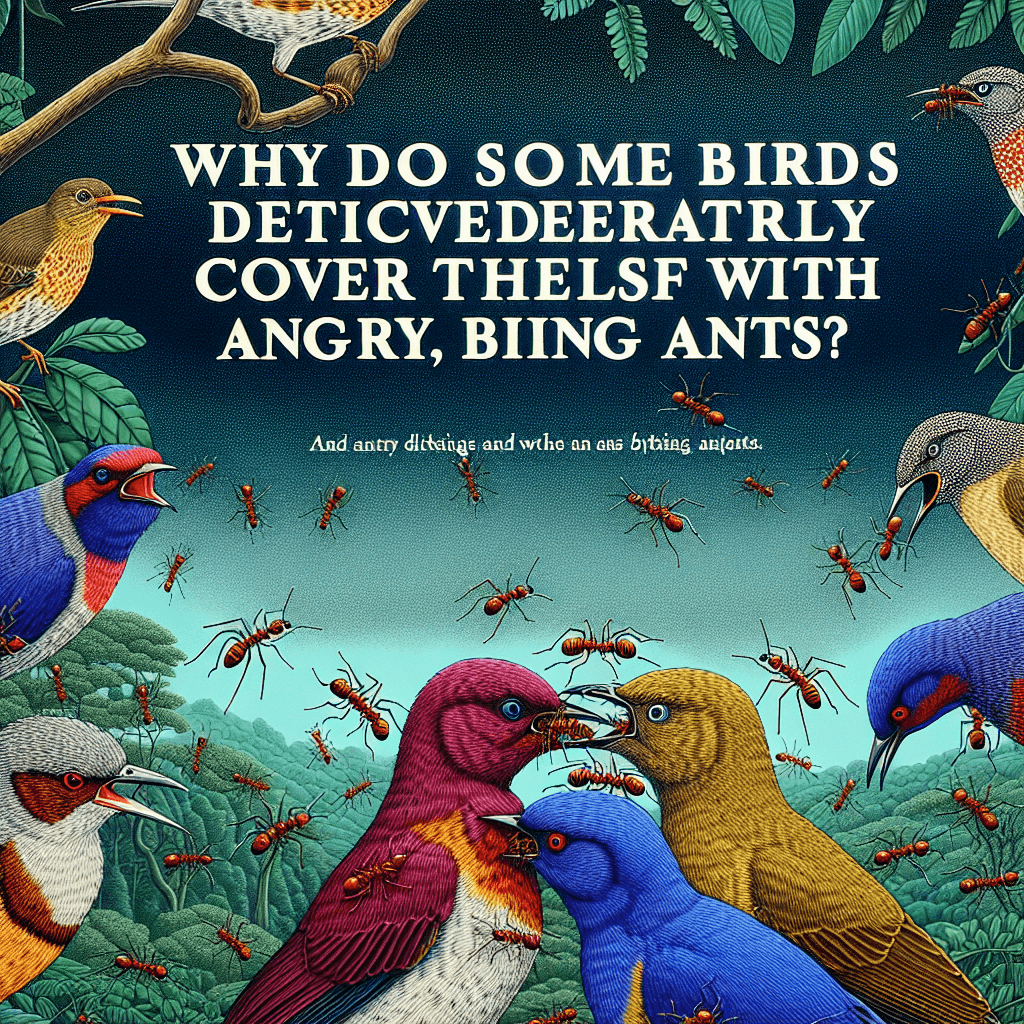Why do some birds deliberately cover themselves with angry, biting ants
It sounds like a form of feathery self-torture, but for some birds, a swarm of biting ants is a trip to the spa. Uncover the astonishing reason they willingly embrace the sting.


Too Long; Didn't Read
TLDR: Birds provoke ants to spray formic acid on their feathers. This acid acts as a powerful natural insecticide and fungicide, killing off harmful parasites like mites and lice and helping with feather maintenance.
Anting Explained: Why Do Some Birds Deliberately Cover Themselves with Angry, Biting Ants?
Imagine watching a blue jay in your backyard. Instead of foraging for food or chirping from a branch, it lands on an anthill, picks up a squirming ant, and meticulously rubs it all over its feathers. It repeats this, looking almost entranced, as the agitated ants bite and spray their defensive chemicals. This bizarre and seemingly painful ritual is not a strange accident; it's a deliberate behavior known as "anting." Practiced by over 200 bird species, from crows and robins to starlings, this fascinating activity has puzzled ornithologists for decades. This post will delve into the strange world of anting to explore the leading theories behind why birds willingly subject themselves to an insect assault.
What Exactly is 'Anting'?
Anting is the act of a bird using ants, and the chemicals they secrete, to preen or care for its feathers and skin. While the exact methods can vary, ornithologists generally classify the behavior into two main types:
- Active Anting: This is the more common method. The bird picks up one or more ants in its beak and rubs them directly onto its plumage, typically under the wings and near the tail. The bird carefully crushes the ant just enough to make it release its defensive secretions without killing it immediately.
- Passive Anting: In this method, a bird will find an anthill and simply lie down on it. It will spread its wings and tail feathers, allowing the agitated ants to swarm all over its body, biting and spraying their formic acid directly onto the bird's skin and feathers.
Regardless of the method, the goal is the same: to get coated in the ants' potent chemical defenses. But for what purpose?
The Million-Dollar Question: Why Do It?
While the exact reason for anting is still debated, scientists have proposed several compelling theories. The most widely accepted explanations center on hygiene, self-medication, and feather maintenance.
The "Pesticide" Hypothesis
The most prominent theory is that anting is a form of pest control. Many ant species, when threatened, spray formic acid—a powerful chemical that acts as a natural insecticide, fungicide, and bactericide. For a bird, feathers are a breeding ground for parasites like feather mites, lice, and ticks. These pests can damage feathers, cause skin irritation, and transmit diseases.
By rubbing ants on their plumage, birds are essentially applying a natural pesticide. The formic acid can kill or deter these harmful parasites, helping the bird maintain a healthy and functional coat of feathers. A clean, well-maintained plumage is critical for flight, insulation against cold, and waterproofing. This theory presents anting as a clever and resourceful form of self-medication—an avian spa day with a practical purpose.
A Soothing Skin Treatment?
Another theory suggests that anting serves to soothe the bird's skin, particularly during molting. Molting, the process of shedding old feathers and growing new ones, can be an uncomfortable and irritating experience. The new "pinfeathers" emerging from the skin can cause significant itchiness.
It’s possible that the formic acid and other ant secretions have an analgesic or anti-inflammatory effect that helps to relieve this irritation. The physical stimulation of the ants crawling and biting might also help to dislodge old, stubborn feathers and clean the skin, promoting healthier regrowth.
A Form of Self-Stimulation?
A more speculative but intriguing idea is that anting might just feel good. Some researchers have noted that birds engaged in anting appear to be in a state of "ecstasy" or trance-like bliss. The chemical compounds released by the ants could be absorbed through the skin and have a stimulating or even narcotic-like effect. While this is difficult to prove, the observed behavior suggests there may be more to anting than just practical hygiene. It's also possible that birds use ant secretions to supplement their own preen oil, making their feathers unpalatable to would-be predators.
A Curious Conclusion
The sight of a bird inviting an attack from a swarm of biting ants is undeniably strange. However, this behavior, known as anting, is a remarkable example of animal ingenuity. While the "pesticide" hypothesis remains the strongest explanation, it's likely that anting serves multiple functions, from ridding the body of parasites to soothing irritated skin during a molt. It’s a powerful reminder that even the most common backyard birds lead complex lives filled with fascinating and sophisticated behaviors. The next time you see a bird acting strangely around an anthill, you’ll know you might be witnessing one of nature’s most peculiar and effective self-care routines.
More Articles

Why do some goats completely freeze up and fall over when startled?
It looks like a dramatic faint, but these goats never actually lose consciousness—discover the bizarre genetic glitch that causes their muscles to instantly go rigid and send them toppling over.

Why did Napoleon's soldiers' buttons turn to dust in the freezing Russian cold?
It wasn't just the cannons or the Cossacks that defeated the Grande Armée; the unraveling of Napoleon's empire may have started with a bizarre chemical reaction in the very buttons holding their coats together.

Why do scorpions glow a brilliant blue-green color under an ultraviolet light?
A scorpion's deadly sting is famous, but its most baffling secret is the brilliant blue-green glow it hides in plain sight.